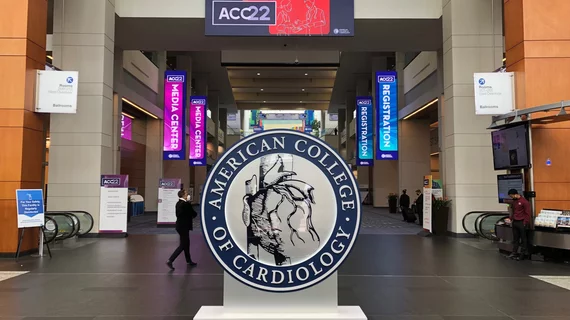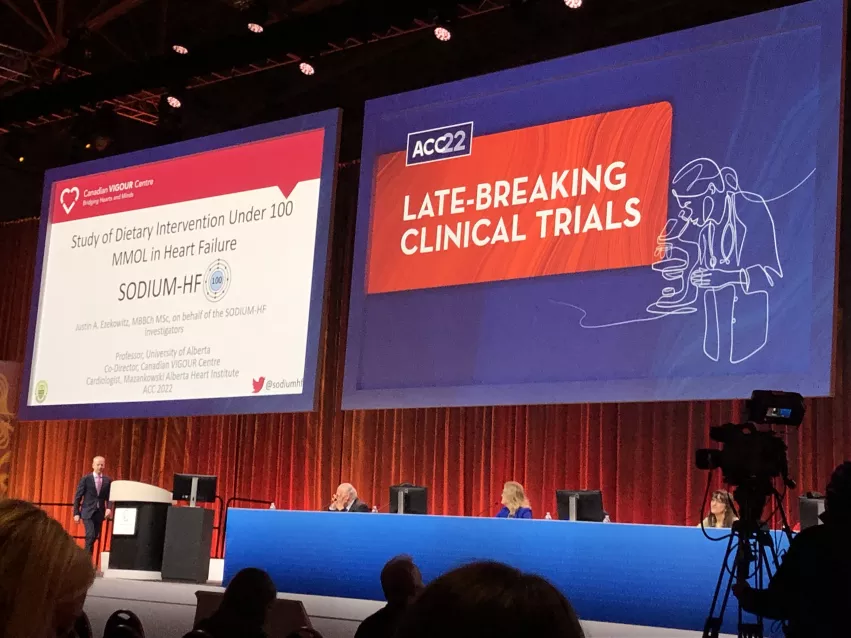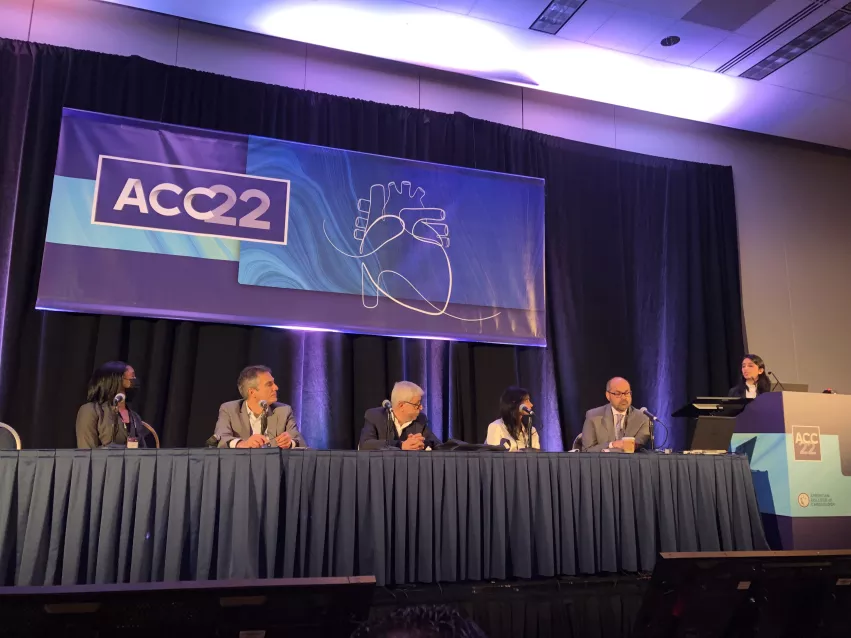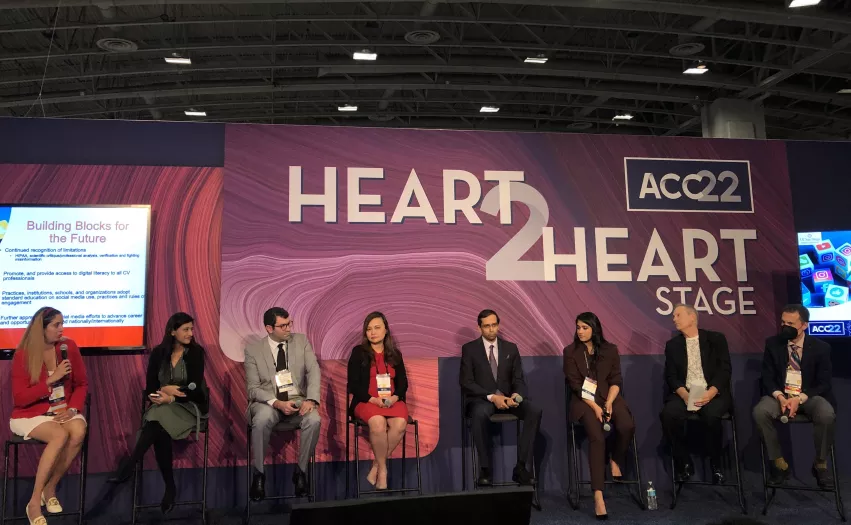Salt restrictions, PCI breakthroughs and a social media primer for cardiologists: Day 1 at ACC.22
ACC.22, the American College of Cardiology’s 71st Annual Scientific Session & Expo, is underway in Washington, D.C., giving many cardiology professionals their first taste of an in-person conference since the start of the COVID-19 pandemic.
The first day at ACC.22 was jam-packed with late-breaking clinical trials, sessions, early looks at state-of-the-art technology and camaraderie. The festivities formally kicked off with an opening showcase featuring ACC President Dipti Itchhaporia, MD. In her presidential remarks, she reflected on the many challenges healthcare providers have faced since the pandemic began while also looking ahead to the promise of the future. Historians, Itchhaporia said, will look back and judge how this generation’s doctors and scientists responded to the pandemic. She is proud of what those historians will find.
“We did not languish this past year,” she said. “We flourished.”
Itchhaporia also emphasized the importance of empathy moving forward — not just empathy for patients, but for the care teams that treat those patients as well. In addition, she emphasized the ACC’s support of those suffering during the ongoing war in Ukraine and highlighted the 20-year anniversary of transcatheter aortic valve replacement.
This opening session was followed by the conference’s first round of late-breaking clinical trials. Milind Y. Desai, MD, MBA, director of clinical operations at Cleveland Clinic’s Heart Vascular and Thoracic Institute and lead author of the VALOR-HCM study, started off by presenting his team’s finding that mavacamten can significantly reduce the need for septal reduction therapy (SRT) among patients with obstructive hypertrophic cardiomyopathy (HCM).
After 16 weeks of treatment, just 17.9% of HCM patients treated with mavacamten were still eligible for SRT—compared to 76.8% of patients treated with a placebo.
Justin A. Ezekowitz, MBBCh, professor of medicine at the University of Alberta, Edmonton in Canada, was next. Ezekowitz, lead author of the SODIUM-HF trial, shared his team’s finding that limiting salt intake for one full year does not significantly reduce a heart failure patient’s risk of major adverse events or hospitalizations compared to usual care.
Limiting salt, however, did result in “modest” benefits in quality of life when looking at each patient’s New York Heart Association class and Kansas City Cardiomyopathy Questionnaire score before and after the intervention.
Another key late-breaking clinical trial looked at the potential impact of regularly treating patients with tranexamic acid (TXA) before noncardiac surgery. P.J. Devereaux, MD, PhD, director of the Division of Perioperative Care at McMaster University in Hamilton, Canada, was lead author of the POISE-3 trial. The study included data from more than 9,500 patients from 22 different countries with a mean age of 70. Overall, Devereaux reported, TXA did reduce the risk of the composite of life-threatening, major and critical organ bleeding events.
More research is still needed in this area, Deveraux noted, but he said up to 8 million bleeding events worldwide could potentially be avoided if TXA treatment before noncardiac surgery became the new normal.
Another key session from the conference’s first day was, “It’s Not Gruentzig's Cath Lab: New Technologies for Better PCI,” a look at new technologies designed to improve both PCI outcomes and the safety of interventional cardiologists performing PCI in the cath lab.
Carlos A. Collet, MD, co-director of the Cardiovascular Center OLV-Aalst in Belgium, focused on the multiple benefits of CT-guided PCI, while Megha Prasad, MD, MS, of the Columbia University Department of Medicine, focused on contrast use during PCI procedures.
Ranya N. Sweiss, MD, MS, associate professor of medicine at the Northwestern University Feinberg School of Medicine, sparked perhaps the most engaged discussion during the session with her examination of new technologies designed to reduce radiation exposure among interventional cardiologists. And Taishi Hirai, MD, a specialist with the University of Missouri Healthcare, provided an in-depth look at the world of robotic-assisted PCI, noting that his team is hoping to perform a significant number of all PCI procedures this way moving forward.
Social media — particularly Facebook, Instagram, TikTok and Twitter — is everywhere right now. But how can cardiologists use these tools to engage with patients, connect with one another, share research and build their own personal brands? A team of cardiologists with extensive backgrounds in social media joined forces Saturday for a session on that very topic.
“Social Media for Cardiologists: Why, When, How & Where?” included input from a variety of presenters. Aamisha Gupta, MD, for example, is a pediatric cardiologist at Rady Children’s Hospital San Diego known for her content on Instagram and other social media platforms. Gupta noted that, as big as these platforms are right now, there is plenty of room for everyone to find their own niche and deliver a unique take on whichever topic they may choose.
“We don’t all have to be influencers,” Gupta said. “But I do encourage all of you to engage.”
Deepak L. Bhatt, MD, MPH, a professor at Harvard Medical School and well-known social media user, compared these platforms to a bookstore, noting that there is a lot of good and bad to be found. A back-and-forth discussion on Twitter, for instance, might help a cardiology researcher consider a better methodology or make a new connection they had previously missed. On the other hand, communicating on Twitter can also lead to harsh criticisms—or another user could just flat-out steal your idea.
Bhatt also took some time to recognize LinkedIn, a career-focused social media platform that often gets forgotten in these discussions. LinkedIn tends to be more positive than, say, Instagram or Twitter, he said.
Another key comment came from C. Michael Gibson, MD, president and CEO of the Baim Institute for Clinical Research and a professor at Harvard Medical School. Gibson pointed out that an ongoing trend in social media has been that content keeps getting shorter and shorter, with creators now providing videos that may last for just a few seconds at a time. A nice alternative, he said, would be if things could start to move in the other direction as well, with social media users taking the time to provide longer, more detailed takes that can actually maintain a person’s attention.
“We don’t just need snacks,” he said. “We need a full meal.”
ACC 2022 Conference Coverage:
Links to all the ACC 2022 late-breaking clinical trials
Cholesterol medications, flu shots and heart failure: Day 2 at ACC.22
TAVR vs. surgery, FFR-guided PCI and DCB safety: Day 3 at ACC.22
VIDEO: TAVR durability outperforms surgical valves — Interview with Michael Reardon, MD
Key Interventional Cardiology Takeaways at ACC 2022
Find more ACC news, video and photos
VIDEO: Use of mRNA drug to lower lipoprotein(a) by up to 98% — interview with Steven E. Nissen, MD.




